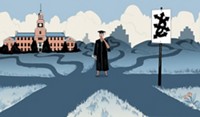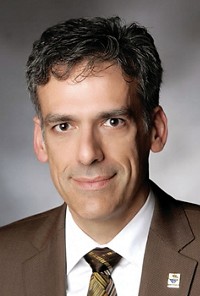Advertisement
Grab your lab coat. Let's get started
Welcome!
Welcome!
Create an account below to get 6 C&EN articles per month, receive newsletters and more - all free.
It seems this is your first time logging in online. Please enter the following information to continue.
As an ACS member you automatically get access to this site. All we need is few more details to create your reading experience.
Not you? Sign in with a different account.
Not you? Sign in with a different account.
ERROR 1
ERROR 1
ERROR 2
ERROR 2
ERROR 2
ERROR 2
ERROR 2
Password and Confirm password must match.
If you have an ACS member number, please enter it here so we can link this account to your membership. (optional)
ERROR 2
ACS values your privacy. By submitting your information, you are gaining access to C&EN and subscribing to our weekly newsletter. We use the information you provide to make your reading experience better, and we will never sell your data to third party members.
Careers
Primarily Undergraduate Institutions
May 26, 2008
| A version of this story appeared in
Volume 86, Issue 21
Cindy Samet makes some very good points in her letter about family-friendly liberal arts colleges (C&EN, April 28, page 6). In particular, she emphasizes the differences in the path to tenure at large research universities and primarily undergraduate institutions (PUIs). She goes on to say that ACS and C&EN focus more on careers at universities than at PUIs. She offers as one piece of evidence "an ACS workshop designed to give doctoral students a better understanding of their career options after graduate school," and states that "there was no mention of liberal arts colleges at this workshop."
In fact, the ACS workshop to which Samet refers, "Preparing for Life After Graduate School" (PfLAGS), discusses careers for chemists in industry (large and small), government service, and academe. The discussion of academic careers covers community colleges and liberal arts colleges as well as research universities. Careers at liberal arts colleges are covered in equal proportion to those at research universities. All presentations of PfLAGS compare academic careers at research universities and PUIs in terms of expectations for time spent in teaching, research, and service.
Each workshop includes a presentation by a faculty member who is currently teaching or has taught at a PUI and who discusses the major differences between this career and one at a research university. These PUI presentations have uniformly been given with distinction and clarity. In addition, PfLAGS includes tips on how to prepare for a job search at a PUI, including information on writing a statement of teaching philosophy and obtaining the classroom experience that many PUIs value in their job candidates.
The presenters of ACS PfLAGS workshops hope to serve all attendees, including the substantial numbers who wish to teach at a PUI, offering a valuable perspective on their career options and what it takes to achieve each option.
Joel Shulman
Cincinnati
The differences between teaching at an undergraduate college and at a research institution are great. While the latter are full of successful research faculty and can effectively advise their students about this career, these same advisers have less understanding of life at a primarily undergraduate institution.
As department chair at a PUI, I have led a fair number of faculty searches. The poor quality of many applications and the questions I field from our recent B.S. graduates nearing their Ph.D. motivates me to offer some guidance to aspiring PUI faculty.
Advancement of knowledge is part of a research institution's mission statement. You are expected to be on the cutting edge of knowledge. In many ways, you operate as an entrepreneur under the umbrella of the department. Your job is to write proposals and get grants, which then support your group's research to be published in first-rank journals. Promotion and tenure criteria are quite clear on that point. Teaching is not ignored but is clearly secondary in importance. Because individual research productivity is the primary criterion of merit, a competitive atmosphere is not uncommon, and productive "prima donnas" are tolerated.
To get this kind of position you need a postdoc or two, substantial and significant publications, and an interesting research plan that promises to produce results of considerable significance.
Teaching is the core of a PUI's mission, and that is indeed your job. You will be evaluated and your performance taken seriously. Although the tenure review includes three criteria, teaching, scholarship, and service, I tell our young faculty to spend their first year or two getting good at teaching. If they aren't good teachers early, they won't be around long enough for us to find out about anything else.
An undergraduate chemistry program is highly collaborative. In a good department, the attitude is, "We're all in this together."
Research is expected, but for very different purposes than at a research institution: First, to keep you current in your discipline and on the cutting edge, and second, as part of your students' education, they are your apprentices. It is thus judged by different criteria. The faculty handbook should have a statement on the role of scholarship as part of the school's promotion and tenure standards. The department may also have a more narrowly focused one. Ask for them.
We take this process very seriously. Young faculty members are the future of the institution. An unsuccessful faculty member is a disaster for all concerned.
Frederick C. Sauls
Wilkes-Barre, Pa.
I wholly agree with Samet's observations about small liberal arts colleges. I taught chemistry for 25 years at Oklahoma Panhandle State University, which has about 1,100 students. The department had two or three chemistry professors.
Those small schools have a large percentage of female faculty members. Although our science department had fewer female professors, I feel we were much more gender-neutral, considering all students worthy of the best teaching effort we could present. We produced a significant number of students who are prepared for and directed toward graduate and professional schools, with equal effort toward both sexes.
Students now worry about the cost of an education, but a comparison of costs and "exchange rates" will show that an education in the 1960s cost me every bit as much as students are now paying. I earned 50-60 cents per hour; undergraduate lab assistants now earn over $5.00 per hour. Gasoline cost me 25-30 cents per gal; a used car cost me $100. The monetary "exchange rate" is 10:1, so a student debt of $30,000 now compares with what I owed when I graduated in the 1960s.
Students now will find that they can get every bit as good an education in the small departments as they can at "Enormous State University." But a small school will take a greater interest in them and help them along, even getting them into the next step in training, and all at a lower cost per year.
Our students were accepted into professional and graduate programs, so nothing was lost. All was gained in their four years in a school of 1,100 students. When we recommended a student, that student "got in." Don't sell them short; those schools are an excellent route to a successful life.
James W. Hill
Emporia, Kan.




Join the conversation
Contact the reporter
Submit a Letter to the Editor for publication
Engage with us on Twitter